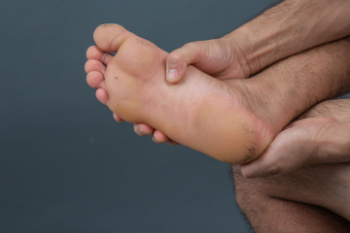Connect With Us
Blog

Measuring shoe size accurately at home ensures a comfortable and well-fitting footwear choice. Begin by gathering a piece of paper, a pen or pencil, a ruler or tape measure, and the pair of socks you intend to wear with the shoes. Place the paper flat on the floor against a wall and stand on it with your heel against the wall. With the pen or pencil held perpendicular to the paper, trace the outline of your foot. Use the ruler or tape measure to measure the longest distance from the heel to the tip of your longest toe. Repeat this process for the other foot as sizes may differ slightly. Compare the measurements to a shoe size chart available online or from shoe retailers to determine your correct size. Foot size may change over time, so it is advisable to measure periodically, especially before making new shoe purchases. If you have developed foot conditions from wearing shoes that do not fit well, it is suggested that you schedule an appointment with a podiatrist who can offer you treatment options, in addition to providing additional information about how to obtain the right shoe size.
Finding a properly-fitting shoe is important in reducing injuries and preventing foot problems. For more information about treatment, contact Patricia A. Kirk, DPM from Kirk Podiatry. Our doctor will treat your foot and ankle needs.
Proper Shoe Fitting
A common concern when it comes to foot health, having properly fitted shoes can help prevent injuries to the foot. Out feet affect our posture and gait, which in turn affects the biomechanics and overall bodily structure. With 33 joints, 26 bones, and over 100 ligaments, the potential for serious injury is much greater than one realizes. Although the feet cease growth in adulthood, they still change shape as they mature. Here are some factors to consider when it comes to investing in proper fitting shoes:
- Be sure the shoes fit correctly right away
- Ensure the ball of your foot fits comfortably in the widest portion of the shoes
- Even though they may look fashionable, improper fitting shoes can either create adverse conditions or exacerbate existing ones you may already have
- Walk along a carpeted surface to ensure the shoes comfortably fit during normal activity
Keeping in mind how shoes fit the biomechanics of your body, properly-fitting shoes are vitally important. Fortunately, it is not difficult to acquire footwear that fits correctly. Be sure to wear shoes that support the overall structure of your body. Do your feet a favor and invest in several pairs of well-fitted shoes today.
If you have any questions please feel free to contact our office located in Lexington, TN . We offer the newest diagnostic and treatment technologies for all your foot and ankle needs.

Cracked heels, a common foot ailment, can be uncomfortable and unsightly, but with proactive measures, they can be preventable. Hydration is key. Moisturizing your feet daily with a rich foot cream or lotion can help, especially by paying extra attention to the heels. Exfoliate regularly to remove dead skin cells and prevent buildup, but avoid overdoing it, as excessive scrubbing can exacerbate the problem. Wear properly fitting shoes with adequate support to prevent friction and pressure on the heels. It is helpful to choose socks that are made of breathable materials to keep feet dry and reduce the risk of moisture-related cracks. Cushion your heels with silicone heel cups or pads, especially if you spend long hours standing or walking. Avoid walking barefoot, particularly on hard surfaces, to minimize stress on the heels. Lastly, maintain a healthy diet rich in vitamins and minerals essential for skin health. Cracked heels can be uncomfortable, bleed, and become infected. If you have this condition, it is suggested that you schedule an appointment with a podiatrist who can effectively treat cracked heels.
Cracked heels are unsightly and can cause further damage to your shoes and feet. If you have any concerns, contact Patricia A. Kirk, DPM from Kirk Podiatry. Our doctor can provide the care you need to keep you pain-free and on your feet.
Cracked Heels
Cracked heels appear unappealing and can make it harder for you walk around in sandals. Aside from looking unpleasant, cracked heels can also tear stockings, socks, and wear out your shoes. There are several methods to help restore a cracked heel and prevent further damage.
How Do You Get Them?
Dry skin is the number one culprit in creating cracked heels. Many athletes, walkers, joggers, and even swimmers suffer from cracked heels. Age and skin oil production play a role to getting cracked heels as well.
Promote Healing
Over the counter medicines can help, especially for those that need instant relief or who suffer from chronic dry feet.
Wear Socks – Wearing socks with medicated creams helps lock in moisture.
Moisturizers – Applying both day and night will help alleviate dryness which causes cracking.
Pumice Stones – These exfoliate and remove dead skin, which allows for smoother moisturizer application and better absorption into the skin.
Change in Diet
Eating healthy with a well-balanced diet will give the skin a fresh and radiant look. Your body responds to the kinds of food you ingest. Omega-3 fatty acids and zinc supplements can also revitalize skin tissue.
Most importantly, seek professional help if unsure how to proceed in treating cracked heels. A podiatrist will help you with any questions or information needed.
If you have any questions, please feel free to contact our office located in Lexington, TN . We offer the newest diagnostic and treatment technologies for all your foot care needs.

Baseball, a sport known for its agility and athleticism, can exert significant strain on the feet and ankles of players. The repetitive motions involved in running, pivoting, and sliding can lead to various foot and ankle injuries. Ankle sprains are a common occurrence, resulting from sudden twists or turns during gameplay. Additionally, the forceful impact of running and jumping can cause stress fractures in the feet, particularly in the metatarsal bones. Baseball players are also susceptible to conditions like plantar fasciitis due to the repetitive stress placed on the arches while running and batting. Furthermore, cleats worn during gameplay can contribute to foot discomfort and blisters, especially if not properly fitted or worn for extended periods. To manage these risks, it is helpful for players to prioritize proper warm-up routines, wear supportive footwear, and seek prompt medical attention for any signs of injury to ensure optimal foot and ankle health throughout their baseball careers. If you have endured a foot or ankle injury while playing baseball, it is suggested that you schedule an appointment with a podiatrist who can properly treat an array of foot conditions.
Sports related foot and ankle injuries require proper treatment before players can go back to their regular routines. For more information, contact Patricia A. Kirk, DPM of Kirk Podiatry. Our doctor can provide the care you need to keep you pain-free and on your feet.
Sports Related Foot and Ankle Injuries
Foot and ankle injuries are a common occurrence when it comes to athletes of any sport. While many athletes dismiss the initial aches and pains, the truth is that ignoring potential foot and ankle injuries can lead to serious problems. As athletes continue to place pressure and strain the area further, a mild injury can turn into something as serious as a rupture and may lead to a permanent disability. There are many factors that contribute to sports related foot and ankle injuries, which include failure to warm up properly, not providing support or wearing bad footwear. Common injuries and conditions athletes face, including:
- Plantar Fasciitis
- Plantar Fasciosis
- Achilles Tendinitis
- Achilles Tendon Rupture
- Ankle Sprains
Sports related injuries are commonly treated using the RICE method. This includes rest, applying ice to the injured area, compression and elevating the ankle. More serious sprains and injuries may require surgery, which could include arthroscopic and reconstructive surgery. Rehabilitation and therapy may also be required in order to get any recovering athlete to become fully functional again. Any unusual aches and pains an athlete sustains must be evaluated by a licensed, reputable medical professional.
If you have any questions please feel free to contact our office located in Lexington, TN . We offer the newest diagnostic and treatment technologies for all your foot and ankle needs.

